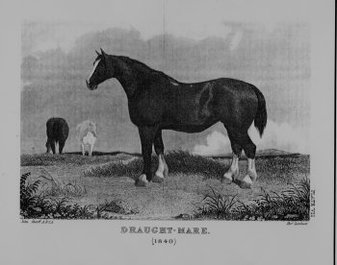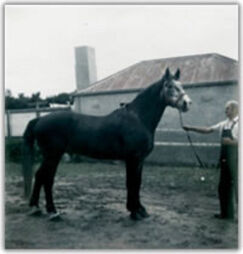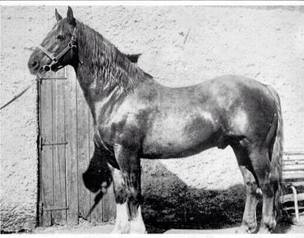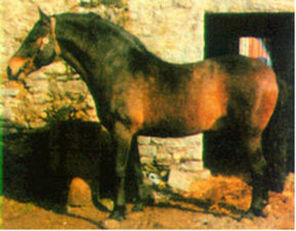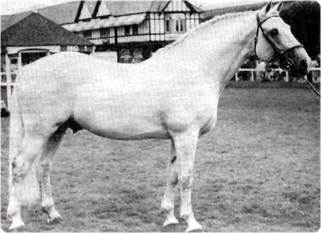|
The history of the Irish Draught dates back many hundreds of years with a distinct Spanish connection. Ireland and Spain were regular traders for many centuries - with Ireland exporting wool, hides and butter, and receiving wine, cloth, horses and specie (money in the form of coins, rather than notes) in return. The class of Spanish horse introduced was the Andalusian Barb, brought to Ireland’s shores in the 16th Century.
|
There is evidence, however, that an oriental influence was present in Ireland prior to direct trade with Spain. The Irish infused their native breed, the Hobby, with heavier Norman blood, which provided much-needed size, substance and strength. Next, the Andalusian was introduced to produce the regal presence – an exquisite top line and light, flowing gaits.
The end result is the incomparable present day Irish Draught, which is a multi-purpose, active farm horse, capable of tilling a small farm, pulling a sidecar to market and milk to the creamery at a steady trot, carrying the farmer out hunting, and breeding a foal each year to sell (usually by a Thoroughbred horse and often to foreign buyers). It had to be quiet to handle, strong and economical to keep. Above all, it had to be dependably sound throughout its working life, because the livelihood of the small farm depended on the reliability and efficiency of this horse.
The end result is the incomparable present day Irish Draught, which is a multi-purpose, active farm horse, capable of tilling a small farm, pulling a sidecar to market and milk to the creamery at a steady trot, carrying the farmer out hunting, and breeding a foal each year to sell (usually by a Thoroughbred horse and often to foreign buyers). It had to be quiet to handle, strong and economical to keep. Above all, it had to be dependably sound throughout its working life, because the livelihood of the small farm depended on the reliability and efficiency of this horse.
The History of the Irish Draught in Australia
|
The first purebred Irish Draught to be imported into Australia was Bantry Bay in 1976.
Dr Arthur Young, a veterinary surgeon from the western district of Victoria, purchased the horse in Ireland as a three-year-old. He was purchased as Silver Laughton, but his name was changed upon arrival to Australia. His sire was Dangan King, by Lahinch, and his dam was Trespain. |
He was a great grandson of the renowned Registered Irish Draught (RID) sire Laughton who also sired many show jumpers, and whose descendants are still actively competing today. He was bred by John Dukelow of Dunbittern, Bantry Bay, in south-west Ireland.
The horse was steel grey and stood at 16.2hh and later matured to 17hh. Arthur remarked that, “I thought at the time (1976) that he would be years ahead of his time, in that the show jumping and eventing fraternity were not interested in breeding horses for these purposes. Instead, content to go through numbers of cheap ex-racehorses to find the odd one that adapted."
"Bantry Bay stood for his first season in 1977 and his last foal crop was 1983. He was bred only to Thoroughbred mares and produced some lovely stock, competing in eventing, show jumping, hunter trials and on the hunt field. Sadly, he died of colic in July 1983. Unfortunately, also in 1983, most of the yearlings and two-year-olds by Bantry Bay perished in the Ash Wednesday fires."
The Australian society, inaugurated in May 1989, has an Irish Draught Stud Book and an Irish Sport Horse Register. Other societies internationally also have their own studbooks and registries. The largest studbook is in Ireland and is administered by Horse Sport Ireland.
The Irish Draught Studbook contains Irish Draught purebreds as well as near purebreds, as the Studbook has a breed back component. This allows the infusion of a small percentage of registered Thoroughbred blood.
The Irish Horse Pedigree Register allows Irish Draughts crossed with other breeds, which may include Australian Stock Horse, Arab, Quarter Horse, Warmblood, and Thoroughbred or other breeds.
In the last 30 years, there have been over 3000 Irish horses recognised and registered in Australia.
The horse was steel grey and stood at 16.2hh and later matured to 17hh. Arthur remarked that, “I thought at the time (1976) that he would be years ahead of his time, in that the show jumping and eventing fraternity were not interested in breeding horses for these purposes. Instead, content to go through numbers of cheap ex-racehorses to find the odd one that adapted."
"Bantry Bay stood for his first season in 1977 and his last foal crop was 1983. He was bred only to Thoroughbred mares and produced some lovely stock, competing in eventing, show jumping, hunter trials and on the hunt field. Sadly, he died of colic in July 1983. Unfortunately, also in 1983, most of the yearlings and two-year-olds by Bantry Bay perished in the Ash Wednesday fires."
The Australian society, inaugurated in May 1989, has an Irish Draught Stud Book and an Irish Sport Horse Register. Other societies internationally also have their own studbooks and registries. The largest studbook is in Ireland and is administered by Horse Sport Ireland.
The Irish Draught Studbook contains Irish Draught purebreds as well as near purebreds, as the Studbook has a breed back component. This allows the infusion of a small percentage of registered Thoroughbred blood.
The Irish Horse Pedigree Register allows Irish Draughts crossed with other breeds, which may include Australian Stock Horse, Arab, Quarter Horse, Warmblood, and Thoroughbred or other breeds.
In the last 30 years, there have been over 3000 Irish horses recognised and registered in Australia.
Society Objectives |
|
The Irish Draught is judged or classified according to the British Breed Standard, which sets out requirements for the breed.
Irish Sport Horses are classified according to the proportion of Irish Draught characteristics displayed, in addition to their pedigree.
Breed Standard |
Type and Character
The Irish Draught Horse is an active, short-shinned, powerful horse with substance and quality. It is proud of bearing, deep of girth and strong of back and quarters. Standing over a lot of ground, it has an exceptionally strong and sound constitution. It has an intelligent and gentle nature and is noted for its docility and common sense. Height Stallions 15.3hh to 16.3hh approx. Mares 15.1hh to 16.1hh approx. Bone Good, strong, clean bone. Head Good, bold eyes set well apart, wide forehead and long, well-set ears. Head should be generous and pleasant, not coarse or hatchet headed, though a slight roman nose is permissible. The jawbones should have enough room to take the gullet and allow for ease of breathing. Shoulders, Neck and Front Shoulders should be clean-cut and not loaded, withers well defined, not coarse; the neck set in high and carried proudly, showing a good length of rein. The chest should not be too broad and beefy. The forearms should be long and muscular, not caught in at the elbows; the knee large and generous, set near the ground, and the cannon bone straight and short, with plenty of flat clean bone, and never back at the knee (calf-kneed) i.e. not sloping forward from knee to fetlock. The bone must not be round or coarse. The legs should be clean and hard with a little hair permissible at the back of the fetlock, as a necessary protection; the pasterns strong and in proportion, not short and upright nor long and weak. The hoof should be generous and sound, not boxy or contracted and there should be plenty of room at the heel. Back, Hindquarters, Body and Hind Legs The back is to be powerful, the girth very deep. The loins must not be weak but the mares must have enough room to carry a foal. The croup to buttocks is to be long and sloping, not short and rounded or flat-topped; hips not wide and plain. Thighs are strong and powerful and at least as wide from the back view as the hips, with the second thighs long and well-developed. The hocks are near the ground and generous, points not too close together or wide apart but straight; they should not be out behind the horse but should be in line from the back of the quarters to the heel to the ground; they should not be over bent or in any way weak. The cannon bone, etc. as for the foreleg should be short and strong. Action Smooth and free but without exaggeration and not heavy or ponderous. Walk and trot to be straight and true with good flexion of the hocks and freedom of the shoulders. Colour Any strong whole colour, including greys. |
A detailed explanation, of what Australian Inspectors are looking for when viewing horses to enter the studbook, can be found in our Members section
It is with great reverence that we remember Bellamont C2, an extraordinary Irish Draught stallion
owned by Sean Lavery of Cootehill, Co. Cavan.
Bellamont was sired by Gortlee Ruler (by Rusheen Lad) out of Oakley Girl (by Oakley Dawn), and while he was classified as Class 2, his pedigree and contribution to the diversity of the Irish Draught herd are unparalleled.
Critical Importance of Bellamont's Pedigree
Bellamont's lineage is of critical importance to the genetic diversity of the Irish Draught breed. There are only two stallions left in the world descending from his Foundation Sire Line, Young Arthur RID 9.
In stark contrast, there are 102 stallions from the Galty Boy RID 97 Line in Ireland alone. This highlights the rarity and uniqueness of Bellamont's bloodline.
Furthermore, Bellamont was a true genetic outcross, with no Pride of Shaunlara, Milestone, or King of Diamonds in his pedigree.
Out of approximately 200 stallions in Ireland, only five or six are considered true outcrosses.
Bellamont's genetic contribution has been invaluable in maintaining the breed's diversity.
In 2023, we received the sad news that Bellamont has been confirmed as deceased. This stallion's legacy, however, will not be forgotten. Bellamont will be remembered as one of the great purebred outcross stallions in history, leaving an indelible mark on the Irish Draught breed.
owned by Sean Lavery of Cootehill, Co. Cavan.
Bellamont was sired by Gortlee Ruler (by Rusheen Lad) out of Oakley Girl (by Oakley Dawn), and while he was classified as Class 2, his pedigree and contribution to the diversity of the Irish Draught herd are unparalleled.
Critical Importance of Bellamont's Pedigree
Bellamont's lineage is of critical importance to the genetic diversity of the Irish Draught breed. There are only two stallions left in the world descending from his Foundation Sire Line, Young Arthur RID 9.
In stark contrast, there are 102 stallions from the Galty Boy RID 97 Line in Ireland alone. This highlights the rarity and uniqueness of Bellamont's bloodline.
Furthermore, Bellamont was a true genetic outcross, with no Pride of Shaunlara, Milestone, or King of Diamonds in his pedigree.
Out of approximately 200 stallions in Ireland, only five or six are considered true outcrosses.
Bellamont's genetic contribution has been invaluable in maintaining the breed's diversity.
In 2023, we received the sad news that Bellamont has been confirmed as deceased. This stallion's legacy, however, will not be forgotten. Bellamont will be remembered as one of the great purebred outcross stallions in history, leaving an indelible mark on the Irish Draught breed.
